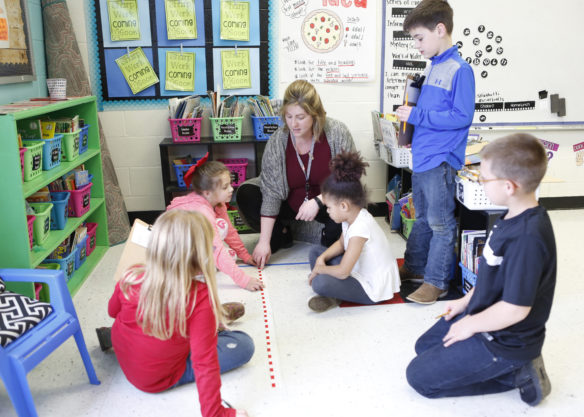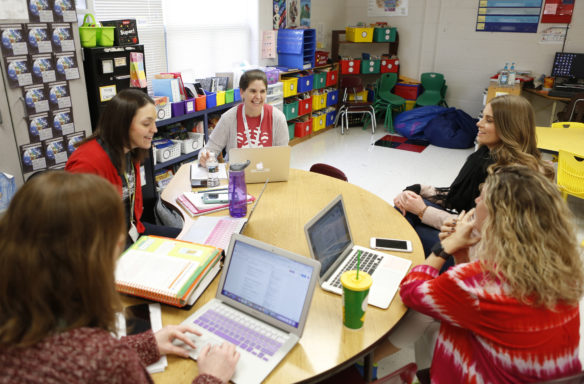
Crystin Moore, center, a teacher at Junction City Elementary School (Boyle County), talks with instructional assistant Christy Zettler, left, in their 4th-grade classroom. General education teachers such as Moore work with special education teachers and instructional assistants in a SHARED (Systematically Helping Achieve Rigorous Engagement Daily) learning model designed to increase student achievement by improving student engagement that is used to improve the reading and mathematics skills of struggling students throughout the district.
Photo by Mike Marsee, Feb. 14, 2019
- Students who are struggling in reading and mathematics are placed in the same classroom at the same time, where they receive instruction from both a general education teacher and a special education teacher.
- Boyle County’s percentage of novice students in reading and math fell sharply over a five-year period.
By Mike Marsee
mike.marsee@education.ky.gov
Changing the outcome for students in Boyle County started with changing the habits of their teachers.
Teachers such as Lisa Brown, a special education teacher at Junction City Elementary School, found themselves spending less time in their own classrooms and more time in collaboration with general education teachers. Teachers such as Crystin Moore, a 4th-grade teacher at the same school, are working side by side with those special education teachers to improve struggling students’ mastery of reading and mathematics.
They and many of their colleagues are helping the Boyle County schools attack the achievement gap through the use of a SHARED (Systematically Helping Achieve Rigorous Engagement Daily) learning model designed to increase student achievement by improving student engagement.
“We realized we weren’t making the gains we should have as far as closing our achievement gap,” said Jane Paynter, the Boyle County schools’ director of special education. “One of the major things that we really focused on was student engagement. We really felt that our students weren’t engaged enough in the classroom, and we might have been creating situations where we were having more gaps by not having engagement.”
Paynter said the district wasn’t making the academic gains it was looking for, with special-needs students and students who qualified for free- and reduced-price meals consistently lagging well behind their peers.
“We really started looking at how we placed students,” she said.
Students in each grade who are struggling in reading and math are placed in the same classroom at the same time, regardless of whether they have an Individual Education Program (IEP). All special education staff members – both certified and classified – are assigned to these shared learning classrooms, meaning there are two or three adults in each classroom.
“Our students at every level are getting small group instruction,” Paynter said. “We have kids ask, ‘Can I be in that co-teaching classroom?’ Kids that don’t have an IEP will ask, because they know that they’re going to get extra help.”

Abby Hill, a special education teacher at Junction City Elementary School (Boyle County), shows a group of 2nd-grade students how to measure the distance of a student’s leap. Special education teachers who might once have been in general education classrooms only in a support role are teaching alongside general education teachers in shared learning classrooms.
Photo by Mike Marsee, Feb. 14, 2019
The results during the five years or so that the SHARED learning model has been in use have been exactly what district officials had hoped to see. For example, in K-PREP assessments from the 2013-2014 school year to the 2017-2018 school year:
- The percentage of elementary school students with disabilities scoring at the Novice level in mathematics dropped from 28.2 percent in 2013-2014 to 10 percent in 2017-2018, while the percentage of those students scoring at the Proficient or Distinguished level rose from 29.8 percent to 52 percent during the same period.
- The percentage of middle school students with disabilities scoring at the Novice level in mathematics dropped from 24.5 percent in 2013-2014 to 6.8 percent in 2017-2018.
- The percentage of middle school students with disabilities scoring at the Proficient or Distinguished level rose from 31.1 percent in 2013-2014 to 52.4 percent in 2017-2018.
“We could use data from any subgroup and we could use any set of data. It all shows the same trend, which is a major reduction of Novice and a major increase of students who score Proficient,” Assistant Superintendent David Young said.
Struggling students are able to receive small-group instruction in reading and math throughout the day, and general education and special education teachers are breaking their lessons into bite-size chunks that can be taught quickly and assessed immediately.
Special education teachers who might once have been in general education classrooms only in a support role are now teaching, which maximizes the district’s talent. They are defined either as reading or math specialists, which allows them to focus on a single subject area and helps students to learn the content at a high level.
Chelsea Clark, a general education teacher at Woodlawn Elementary, said the model has had a positive impact on classroom management as well.
“When you get very similar group of students in the room, one fear might be behavior, but having two teachers, you’re able to manage the students,” Clark said. “You build relationships with the students and it’s a positive impact for everyone. Everyone is lifted up. They interact with their peers better, their social skills are improved, they know how to interact with adults. There are a lot of bonuses to this model.”
The SHARED learning model’s roots can be traced to Junction City, one of the district’s three elementary schools. A station teaching model was employed there by Principal Pam Shunk, who had previously spent 20 years in the Fayette County schools and had seen the process used there.
“One of the things that I felt could be improved was our special ed services,” Shunk said. “We had and still do have a significant number of kids who are in special ed, but we also have a lot of kids who would benefit from the expertise of a special ed teacher even though they’re not identified. We group the kids who are going to need the services, and then we schedule each of the special ed teachers based on those kids.”
In the station teaching model used at Junction City, that means pairing one of five special education teachers with a general education teacher at each grade level. Students are divided into three groups within the class based on academic performance, and they rotate between a general education teacher who teaches the core lesson, a special education teacher who helps struggling learners close gaps, and either an instructional assistant or a time of independent work on assignments.
At the end of the rotation, students take an exit slip, a learning check that indicates whether a student has mastered the content being taught that day. The exit slip consists of a few questions aligned to the day’s intended learning that are used to measure a student’s level of understanding. Teachers use the exit slip data to determine whether information has been mastered or needs to be revisited.
Another teaching model used in the district is “chunking,” in which teachers present a lesson and introduce a learning target to the entire class in about 10 minutes, after which students break into small groups in which general education teachers, special education teachers and instructional assistants check for understanding and help students practice the skill being taught. Students come together again as a group and teachers deliver the second chunk of the lesson. They again break into small groups to practice the skill being taught while teachers reteach, provide more practice or enrich students. They then are given an exit slip as a group.

Lisa Brown, a special education teacher at Junction City Elementary School (Boyle County), meets with, left to right, 1st-grade teacher Kristen Lucas, 1st-grade teacher Katharyn Stump, student-teacher Caroline Bristow and 1st-grade teacher Heather Lockhart. Special education teachers regularly collaborate with the teachers with whom they co-teach in shared learning classrooms.
Photo by Mike Marsee, Feb. 14, 2019
Planning plays a pivotal role in both teaching methods. General education and special education teachers are given common planning time at least once a week. There often are usually other informal meetings between collaborating teachers, such as during lunch or after school.
“For me, I think the co-planning is the biggest part,” Moore said. “We meet almost every day. We talk about how our students are doing and we bounce ideas off each other, which is really important because any time we notice students struggling, there are two of us to figure out how to help them. We are both able to find resources and strategies to help our students in the skills that they’re showing deficits in.”
Shunk said because special education and general education teachers work so closely together, it’s important that they build a good relationship with each other in order to create multiple connections with a student population that can often feel disconnected.
“If you’re the special ed teacher, it’s a challenge because you’re going into somebody else’s classroom, and you don’t want to step on somebody else’s toes,” she said. “It takes time to build that working relationship with each other, not only from the instructional standpoint but from the class management standpoint, but I think we’re in a really good place right now.”
General education and special education teachers within each classroom are equally responsible for their students, with both responsible for planning, grading, contacting parents and all student data.
“You push yourself to get up to par with the regular ed teacher so there’s not a difference in the two teachers,” said Bobby Leffew, the assistant principal at Junction City Elementary, who was as a special education teacher at Boyle County High School before moving to his current role last year.
Jane Goatley, a special education teacher at Woodlawn Elementary School, said it’s worth the effort.
“It requires a lot of preparation, but it’s proven to be effective and the students love it,” Goatley said. “They’re extremely engaged, behavior incidents are down and it has been extremely successful.”
MORE INFO …
Lisa Brown lisa.brown@boyle.kyschools.us
Chelsea Clark chelsea.clark@boyle.kyschools.us</a
Jane Goatley jane.goatley@boyle.kyschools.us
Bobby Leffew bobby.leffew@boyle.kyschools.us
Crystin Moore crystin.moore@boyle.kyschools.us
Jane Paynter jane.paynter@boyle.kyschools.us
Pam Shunk pam.shunk@boyle.kyschools.us
David Young david.young@boyle.kyschools.us
Boyle County schools’ presentation to the Kentucky Board of Education (begins at 1:20:05; about 25 minutes)



Leave A Comment